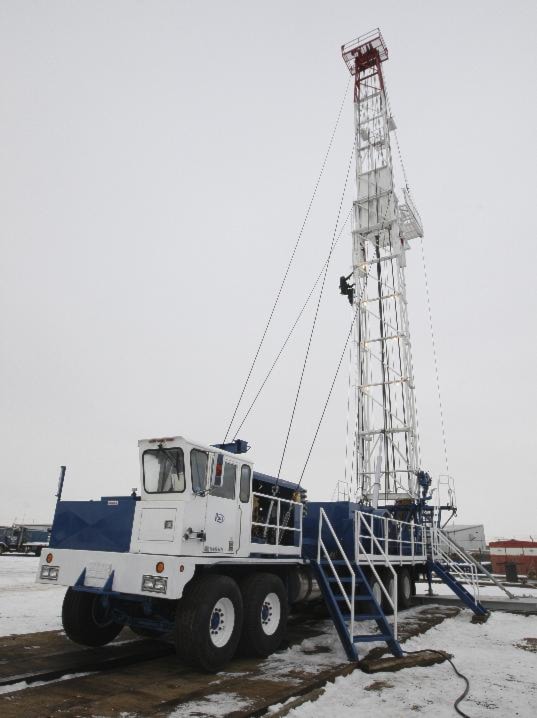Six years ago, energy companies were reeling from the impact of crude oil prices tumbling from US$134 to $57 in just five months. By the time West Texas intermediate (WTI) bottomed out at below $40 a barrel, in February 2009, there were widespread layoffs and even business closures.
Central Alberta, with its high concentration of oil and gas service companies, was hit hard — as was the regional economy.
Fast-forward to 2014 and industry insiders can be forgiven for being a bit nervous. The price of WTI crude dipped below $67.15 on Friday, a $40 slide in five months.
Last week, the Canadian Association of Oilwell Drilling Contractors forecast that drilling activity would decrease by 10 per cent in 2015. And that assumed an average WTI price of $85.
“We think that this is a temporary cycle and we’re going to get back, hopefully, to the $85 territory in the next quarter or so,” said CAODC president Mark Scholz.
But if prices move in the opposite direction?
“If you’re getting below 70 bucks, the economics are not making sense and you could see a lot of blood on the streets,” warned Scholz.
“I can assure you, for some of my private, small to medium-size service rig contracting companies, they’re very worried.”
Even CAODC’s optimistic forecast of $85 oil and a 10 per cent drop in activity will result in some pain, he acknowledged.
“I think there’s going to be an impact on the number of people employed in our business for sure, and there will be certainly an impact on revenues coming into my membership companies.”
One of those members is Red Deer-based Roll’n Oilfield Industries Ltd., a service rig contractor that’s witnessed 37 years of petroleum sector ups and downs. Company president Brad Rowbotham isn’t ready to push the panic button.
“Things can change so quickly,” he pointed out. “A few weeks from now, it could be back up.”
Rowbotham doesn’t anticipate a big drop in activity in the field, even if oil settles in the $75 range.
“A lot of the operators have planned their projects quite far out and made commitments to do certain wells and have contracts with certain suppliers.”
David LeMay, president and CEO of construction giant Stuart Olson — which counts on the energy sector for much of its work — agrees that the industry’s momentum is unlikely to be halted by the current decline in oil revenues.
“We believe that there’s a continuing spend that will continue to happen, almost irrespective of oil prices,” he said during a conference call.
Mark Salkeld, president and CEO of the Petroleum Services Association of Canada, agrees that most companies are unlikely to slash their capital expenditures in response to a few months of low prices.
“I haven’t seen anything or heard anything along the lines of budget cutbacks,” he said last week. “We’ve got member companies that are buying or building new rigs and equipment, fracking equipment, drilling rigs.”
PSAC members are going into the winter with plenty of work in the books, said Salkeld. There’s an “air of caution,” he added, but nobody is sitting idle.
Salkeld also noted that a lot has changed since 2008. Canadian producers are now benefitting from a more favourable exchange rate, and the discount they receive on Western Canadian oil relative to WTI is less.
Todd Hirsch, ATB Financial’s chief economist, reinforced Salkeld’s assessment.
“The Canadian dollar is providing a nice buffer because a lot of our energy is exported,” said Hirsch.
And the price gap between WTI and Western Canadian select has narrowed from about $40 a few years ago to between $18 and $20 now, he continued.
“Even a few weeks ago, it was as low as $12 or $14 a barrel — the gap.”
That’s softened the impact of declining WTI prices.
Another difference from 2008 is the broader economic backdrop, said Hirsch.
“The global economy in 2014 is not in the same sort of frenzied panic that we were in 2008 and 2009.
“We were seeing the financial markets collapsing, we were seeing the housing market in the States collapsing: there was all kinds of chaos and real panic.”
If 2015 oil prices remain in the $75-to-$80 range, as many predict, the industry will experience a slowdown, said Hirsch. But it’s unlikely to cause much pain — and might even provide relief from labour shortages and the strain of overheated development.
“I don’t foresee the kind of situation where we have to brace ourselves for a real sharp correction: a lot of layoffs, a lot of projects being cancelled or delayed,” he said.
Hirsch did caution that the slide in oil prices will hit some players — most notably smaller companies that are reliant on steady cash flows — harder than others. And that will probably result in announcements of certain projects being delayed or cancelled.
“Sometimes when Albertans read those things, they start talking at the water cooler,” observed Hirsch. “And they put off making that purchase of a new home or they feel nervous about things, and quite quickly things can spiral downward even though they don’t need to.”
Ultimately, in the volatile world of energy markets, nothing is certain. Speaking to the Advocate on Nov. 20, when oil was still around $75, Hirsch said: “If next week you call me back and WTI is at $65, then it’s a different conversation again.”
That conversation is now just $1.15 away.
hrichards@www.reddeeradvocate.com
